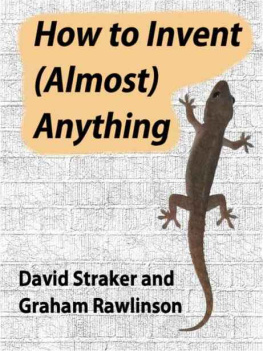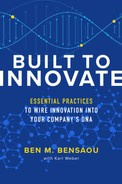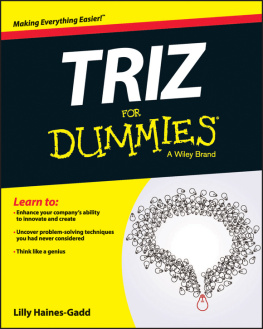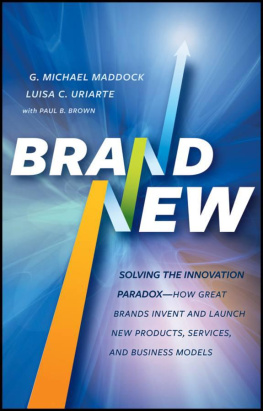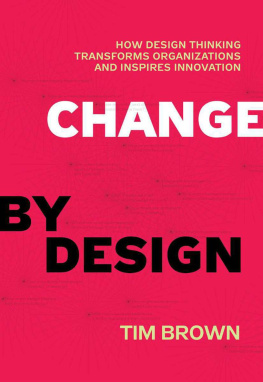How To Invent (Almost) Anything
Serious Innovation
using
Science and Psychology

by
David Straker and Graham Rawlinson
Copyright David Straker and Graham Rawlinson, 2001, 2011
All rights reserved. No part of this book may be reprinted or reproduced or utilized in any form or by any electronic, mechanical, or other means now know or hereafter invented, including photocopying and recording or in any information storage and retrieval system without permission from the authors.
Formatted in Times New Roman and Arial by David Straker
Cover illustration by Heledd Straker
Contents
Break things down and question them. Simple and powerful. |
Energy, matter, space and time. Thats all you have to invent with.
Looking at friction through an unconventional lens.
Hinges, bottle-tops, levers, nuts and bolts, knives. All fall before
simple science!
Heres how 200,000 patentees did it. 6 The TRIZ 7-step process Simplified TRIZ for speedier invention. |
We are just pattern machines. Thats all.
Survival = Control + Identity + Novelty. The fires that make us do what we do.
Sense, understand, decide, act. Theres many a slip.
Go under, around, through. Just dont get blocked. How to set yourself on fire! |
Cold logic, Simple science, TRIZ and psychology. All in one box. |
Preface
When you open a door you usually have some notion of what may lie behind it. You also have some intent in opening the door. Now you have opened this book, do you know why are you here? As authors we do not know your particular journey, so all we can do is to paint a picture of the rooms you are about to explore.
Some of the rooms in this book are quiet places where you can sit and relax, just taking in what you see, reflecting on it and pondering the meaning you find there. These are the reading rooms where you can learn about what goes on in our heads when we are trying to be creative, or the basic principles of science. There is no examination at the end, so take from them what you will and do not worry. Browse, pick up, put down, let your thoughts wander. If you put energy into challenging what we suggest then make it fun so you have more energy after the challenge than before. Do not waste your energy in fighting ghosts!
Some of the rooms are activity rooms. They have a different pace, a get-up-and- do pace. Do not go into these rooms unless you want to do something. Enter them only if you are safe from interruptionsyou will not want to break away from an ideas session just at the point of that brilliant notion. Have things to record your activity, whether it is big sheets of paper or a tape recorder or even a video camera. Do not be embarrassed about taping your thoughts. This may seem crazy but it provides great material for reflection, learning and the next groundbreaking ideas.
We have all created many exciting ideas in our heads, and at the eureka point of discovery we thought that this was it! But in the cold light of the next dawn the glamour and glee may have faded, leaving ordinary-seeming ideas that die in the still glare of cold criticism.
Inventing is not just about the thing you invent; it is about passion, about excitement, about commitment. When you are doing your inventing, if you can see and steer your own internal state, creating and fuelling your own passion, you will find that you have the sustainable energy that is necessary to drive those ideas through from conception to completion.
To be a great inventor, you must thus be both a scientist and a psychologist, engineering both the world around you and the world within. This book supports this cause by painting its rooms from the deep blue of human and scientific understanding to the vermillion hues of action, challenge and excitement.
Inventing is like love. You can read about it, or you can do itand there is a big difference between the two. Doing involves chase, teasing, courage, confusion, persistence, excitement and passion. And the more you do it the more you learn and the better you become. Soenter here the brave and determined. Choose a future that is full of stimulation, passion and invention. And most of all, Have fun!
Graham and Dave
Toolbox 1: Logical Creativity and logic sometimes seem to be at the opposite ends of the spectrum. Far from it--logic is the first tool of all inventors. Many inventive and creative problems have been solved by cold, hard analysis and thinking. You do not always have to daydream and get into the fluffy stuff to solve every problem (although this does become necessary for those problems which do not succumb to the logical approach). |
Analytical Invention
When we started to write this book, we began in the deep theory, but on reviewing it concluded that it would be more helpful to begin with something more immediately useful. If you read no further than this chapter and then go and apply the methods described here, you should be able to invent with the same approach as many great engineers and inventors of the past (although we hope you read on, of course, increasing your skills still further).
There is a whole range of approaches that can be used to create new ideas, ranging from a structured, analytical approach to softer, more conceptual methods. For many inventions, the analytical methods, though simple, are very effective and this is where we will start.
The basis of analytical invention is very simple. First, you decompose, breaking things down into manageable pieces and then you and examine, question and consequently improve the individual parts.
Decomposition
A standard scientific and engineering approach to problems is to decompose the item in question into smaller elements which can be dealt with on an individual basis. This general principle gives rise to a number of methods which are described below.
Chunking
The brain understands things in distinct chunks (see Chapter 8), building large chunks out of smaller chunks. Thus a tree is made from leaves, twigs and branches. We can use this principle of hierarchical analysis to understand many inventive situations.
The simplest method of chunking is to break things down into their individual parts, thus a keyboard may be broken down into keys, casing and connector, with the connector breaking down into sheath, screw, and pin assembly, and so on. The inventive eye can then be focused on very specific aspects, such as the force required to push the pins into the sockets or the ease with which the connector casing can be grasped.
We can also chunk up, looking at the big picture. This is particularly useful in the early stages of invention when you are asking questions like, what is the real problem here? As you chunk up further, you will get to more general, broader areas. You can also then chunk back down through different branches to discover new areas of focus. For example, in Fig. 1.1, we chunk up from supporting a tent to the general problem of support, and then back down to specific alternative ways of providing support.
A trick of chunking is in the questions you ask as you chunk up or down. By changing the questions, you will discover different things. A simple alternative is shown in Fig.1.1, where you chunk down by asking how and chunk up by asking why. You could also ask What is the benefit of doing this? to chunk down, and What problems are solved by doing this? to chunk up.
Next page
